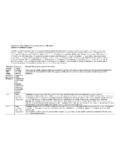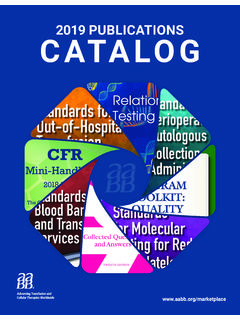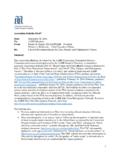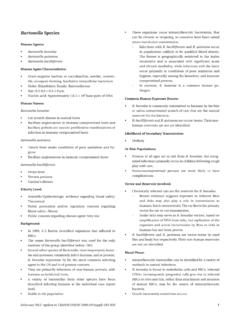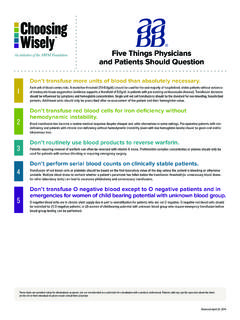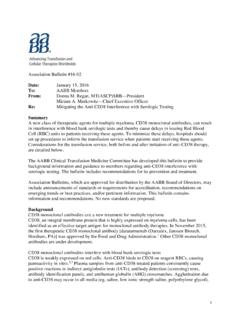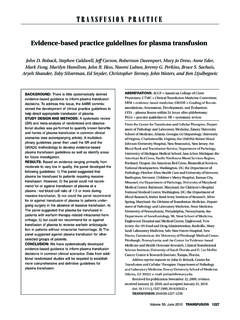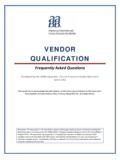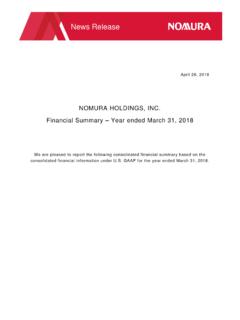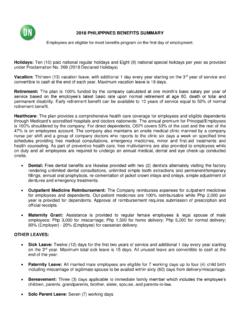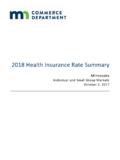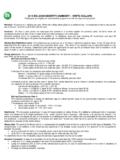Transcription of OPPS 2018 Final Rule Summary - AABB
1 Centers for Medicare & Medicaid Services Finalizes Medicare Hospital Outpatient Payment Policies for 2018 On November 13, 2017, the Centers for Medicare & Medicaid Services (CMS) published in the Federal Register the Final rule updating Medicare payment rates and policies under the hospital outpatient prospective payment system (OPPS) for calendar year 2018 . In general, CMS Final rule increases payment rates under the OPPS by percent. The payment rates for blood and blood products will experience a net reduction of 1 percent, which reflects decreases in payment for certain products as well as increases in payment for other products.
2 In contrast, the payment rates for transfusion, apheresis, and stem cell procedures will experience a net increase of 7 percent and the payment rates for transfusion laboratory services will experience a net increase of 22 percent. Payment Rates and Coding Changes for Blood and Blood Products CMS finalized its proposal to continue establishing separate payment rates for blood and blood products using a blood-specific cost-to-charge (CCR) methodology. Similarly, CMS finalized its proposal to continue to apply the blood-specific CCR methodology when calculating the costs of the blood and blood products that appear on claims with services assigned to comprehensive APCs (C-APCs).
3 Since the costs of blood and blood products are reflected in the overall costs of the C-APCs, CMS finalized its proposal not to make separate payments for blood and blood products when they appear on the same claims as services assigned to the C-APCs. Overall, CMS finalized payment rates for 2018 for blood and blood products that are 1 percent lower than the payment rates finalized for 2017. CMS finalized payment reductions of over 20 percent for four blood products, including: P9011 (blood split units), P9043 (Plasma protein fract,5%,50ml), P9048 (Plasmaprotein fract,5%,250ml) and P9060 (Fr frz plasma donor retested).
4 In contrast, CMS finalized payment increases of over 20 percent for three blood products, including P9044 (Cryoprecipitatereducedplasma), P9056 (Blood, l/r, irradiated) and P9057 (Rbc, frz/deg/wsh, l/r, irrad). The net decrease reflects the elimination of P9072, which was replaced effective July 1, 2017 with two temporary codes Q9988 (platelets, pheresis, pathogen-reduced, each unit) and Q9987 (pathogen(s) test for platelets). CMS Final rule replaces these temporary codes with permanent codes P9073 (platelets, pheresis, pathogen-reduced, each unit) and P9100 (pathogen(s) test for platelets).
5 P9100 is discussed below, under Payment Rates and Coding Changes for Transfusion Laboratory Services. However, the change in payment rates for blood and blood products reflects the addition of P9073, which will be cross-walked to P9037 (leukoreduced, irradiated apheresis platelets) for 2018 and assigned a payment rate of $ CMS responded to commenters concerns about insufficient proposed payment rates for several HCPCS codes for blood and blood products by indicating that the Agency used claims data from CY 2016 and the same blood-specific [CCR] in previous years to calculate these proposed payment rates and believe[s] the changes in costs for the are a result of normal variations in the claims data.
6 In addition, CMS responded to commenters requests that the Agency immediately include the cost of newly implemented FDA blood safety measures for blood and blood products prior to receiving claims data that would contain the costs for the new safety measures, by noting the following: The OPPS covers hospital payments for the costs of blood and blood products, as well as for the costs of collecting, processing, and storing blood and blood products. The cost of blood and blood products is determined using claims data and blood-specific CCRs from hospitals. To the extent that compliance with blood safety measures is included in hospital reporting of the cost of collecting, processing and storing blood and blood products, these costs would be reflected in the hospital rates.
7 It is not possible to estimate the potential costs of new safety measures outside of claims data. CMS specifically noted that the safety of the nation s blood supply continues to be among the highest priorities, and committed to working with stakeholders to ensure that future updates to the HPCPS P-codes are aligned with maintaining the safety of the blood supply. Please see Table 1 for a Summary of the Final payment rates for 2018 for blood and blood products. Payment Rates and Coding Changes for Transfusion, Apheresis, and Stem Cell Procedures Overall, CMS Final payment rates for CY 2018 for transfusion, apheresis, and stem cell procedures are 7 percent higher than the payment rates finalized for 2017.
8 This reflects CMS decision to discontinue and stop paying for 36515 (Apheresis absorp/reinfus) as well as the addition of a new code 38222 (Dx bone marrow bx & aspir). The net increase includes a 10 percent increase in payment for code 38240 (transplt allo hct/donor) as well as increases of between 6 and 17 percent for the other codes. CMS did not finalize its proposal to change to the status indicator assigned to HCPCS code 38205, which applies to harvesting cells from a donor for intended use in a patient, from B to S. The status indicator S indicates that the procedure is paid under the OPPS and receives separate payment, whereas B indicates that a code is not recognized by OPPS when submitted on an outpatient hospital Part B bill (type 12x and 13x).
9 CMS agreed with commenters that this change could have resulted in erroneous billing or misinterpretations by providers since all donor acquisition costs, including the costs for HCPCS code 38205, are required to be reported on the same date of service as the transplant procedure (38240) to be appropriately packaged for payment purposes. Similarly, CMS did not finalize its proposal to assign HCPCS code 38205 to APC 5242. Please see Table 2 for a Summary of the Final payment rates for 2018 for transfusion, apheresis and stem cell procedures. Payment Rates and Coding Changes for Transfusion Laboratory Services With a few exceptions, the Final 2018 payment rates for transfusion laboratory services codes are between 12 and 24 percent higher than the rates finalized for 2017.
10 The The payment rate for 86976 (Rbc serum pretx id dilution) was reduced by 38 percent, which is likely a result of CMS changing the APC code from 5732 to 5731. The payment rates for 2018 for transfusion laboratory services reflect the addition of a new permanent code P9100 which CMS finalized to replace Q9987 (pathogen(s) test for platelets). P9100 is a separately payable testing code, which will be reimbursed at a rate of $ Please see Table 3 for a Summary of the proposed payment rates for transfusion laboratory services. Laboratory Date of Service Policy CMS finalized a new policy applicable to billing for certain advanced diagnostic laboratory tests (ADLTs) and molecular pathology tests.

